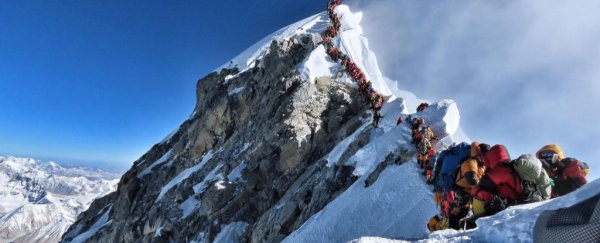Anjali Kulkarni, an Indian mountain climber, trained for six years to make it to the top of Mount Everest, the highest mountain peak in the world. She finally fulfilled her longtime goal when she reached the summit this week. But it was the descent that killed her.
Her son, Shantanu Kulkarni, told CNN that she died after getting stuck in a "traffic jam" on the mountain.
"She had to wait for a long time to reach the summit and descend," Thupden Sherpa, who organized tours on the mountain, told Agence France-Presse.
"She couldn't move down on her own and died as Sherpa guides brought her down."
Two other Indian hikers, Kalpana Das, 52, and Nihal Bagwan, 27, also died this week. Keshav Paudel, who organized tours on the mountain, told AFP that Bagwan was "stuck in the traffic for more than 12 hours and was exhausted."
On Saturday, a 44-year-old British man, Robin Haynes Fisher, died shortly after reaching the summit, bringing the death toll for this season to at least 10, as a few days of clear weather attracted huge numbers of climbers hoping to scale the 29,029-foot (8,848 meter) peak.
"Our guides tried to help but he died soon after," the company Fisher traveled with told the BBC.
A number of other people have died elsewhere in Nepal's Himalayan mountains this season. Nepal has issued around 380 permits for those hoping to climb the mountain, AFP reported.
They cost about US$11,000 each, and hikers are accompanied by local, and sometimes international, guides.
A chilling photograph from Everest (above) shows a long line of mountaineers queuing to ascend a steep ridge to the summit. The photo was shot by Nirmal Purja, an avid mountaineer, who wrote in an Instagram caption that he estimated there were 320 people waiting in line.
Traffic jams create dangerous situations for climbers, who are often already exhausted and carrying heavy loads while battling altitude sickness, which can make people dizzy and nauseated.
Gordon Janow, director of programs at Alpine Ascents International, has been organizing treks to Everest for about 30 years. He said overcrowding often occurs, but "every year seems to be worse and worse."
When a line starts to back up, "you're changing your natural pace so you're spending more time in this high altitude zone than might be necessary if you were climbing 10 to 15 years ago," he said.
Alpine Ascents currently has a group of a dozen climbers on the mountain, he said, and one of the most important skills for the guides who accompany them "is knowing when to turn people around."
"The idea isn't to push yourself to the ultimate maximum to reach the summit," he said. "Then there's no steam or energy left in your body to get down."
Everest attracts climbers from around the globe, and the victims come from diverse backgrounds:
- Séamus Lawless, an assistant professor of computer science at Trinity College in Ireland, went missing May 16 when he slipped and fell shortly near the summit, on a different side of the mountain from where the main traffic jam is taking place.
- The Independent reported that a second Irish climber, Kevin Hynes, died Friday. He had climbed parts of Everest before, and the British group he traveled with, 360 Expeditions, said in a statement that he was "one of the strongest and most experienced climbers on our team."
- Earlier this week an American, Donald Lynn Cash, 55, of Utah, died after falling sick, possibly from the high altitude. It was unclear what role, if any, the traffic jams had in his death.
- And a 65-year-old Austrian man is also among the dead.
Last year, 807 people reached the mountain's summit, more than had ever reached the top in a single year before. When climbers choose to scale Everest, they do so understanding the perils they could encounter along the way.
In addition to the risks of altitude sickness and exhaustion, there have been a number of avalanches on the mountain over the years, including one set off by the catastrophic 7.8 magnitude earthquake that struck Nepal in 2015.
In that instance, an avalanche swept down the mountain and through a base camp, killing at least 18 people and injuring dozens more.
Still, most who make the trek expect to come home.
Cash, who took a sabbatical from his executive job at BMC Software to finish scaling the world's seven highest peaks, wrote on LinkedIn before his trip that he was "excited to look for the next chapter of my career in June when I return. Safely. With all my digits."
Instead, his body will remain on Everest.
2019 © The Washington Post
This article was originally published by The Washington Post.
